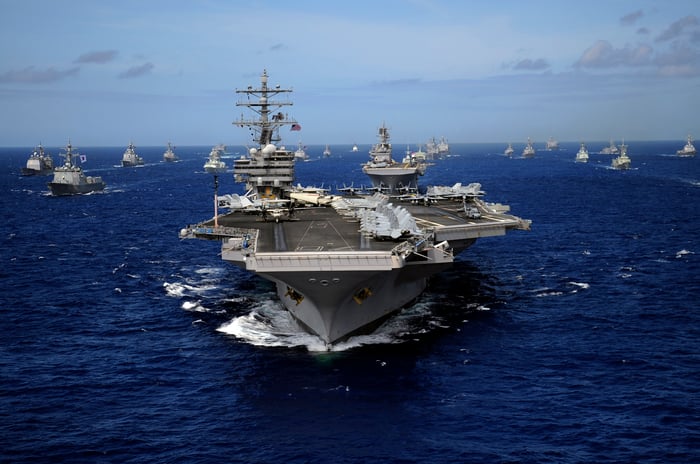DDG(X) is dead. Long live DDG(X)!
It's been nearly three decades since the U.S. Navy first began considering a plan to replace and update its fleet of DDG-51 Arleigh Burke-class guided missile destroyers. The program was first called SC-21 (Surface Combatant for the 21st century), then DD-21 (the Destroyer for the 21st century), and then DDG(X). It ended briefly when the Navy evolved it into the DDG-1000 Zumwalt-class -- a super-destroyer that ended up 50% bigger than a cruiser.
But the DDG-1000 series of warships will end with just three vessels built. And now... the Navy needs a new DDG(X).

Image source: Getty Images.
Once more, with feeling
In contrast to the last go round, this time it looks like the Navy may speed things up a bit and try to get DDG(X) in the water a bit sooner. This new and improved DDG(X) program was only announced last year, and already it looks like the Navy is making some progress.
The Navy has announced that its two favorite military shipbuilders -- Huntington Ingalls (HII -0.26%) and General Dynamics (GD -1.08%) -- will assist with development of DDG(X). And just last week, as USNI reported, the Navy gave further details, noting among other things that the Navy itself will "lead on design," and only use Huntington Ingalls and General Dynamics to "inform" the effort.
One effect of this should be a faster shift from design to construction. According to the U.S. Government Accountability Office (GAO), "scale-model testing and simulations" for DDG(X) are scheduled to begin just two years from now. USNI reports that fabrication work on the first new DDG(X) destroyer could begin as early as 2028 -- just seven years from project launch. Helping to speed things along will be a plan to take existing "proven combat systems" and incorporate them into a new hull that is bigger (about 12,700 tons) and capable of generating more power, and thus better suited for carrying 21st century weapon systems such as hypersonic missiles and laser cannons.
This should simplify things for the defense contractors. All they really have to do is design bigger, better hulls to haul around the combat systems, and some more robust engines to power them. But after that's accomplished, investors might wonder, what else will there be for Huntington Ingalls and General Dynamics to do?
Well, once the designs are "mature," it will be their job to build the new warship -- and that should be more than enough to make investors happy.
DDG(X) -- in dollars and cents
The GAO does not yet have an official estimate on how much the Navy might end up spending on DDG(X). At this early stage, most estimates are still listed as simply TBD.
Still, GAO anticipates the first ship (on which most manufacturing kinks will be worked out) could cost as much as $4 billion. By ship 10, the Congressional Research Service (CRS) reports that the Navy wants to get prices down to $2.5 billion, tops. Ultimately, CRS estimates that cost per ship should average $2.9 billion.
Investors' reply: $2.9 billion times how many ships? That, too, remains TBD, but CRS has some thoughts on the matter: "Procuring 11 [new destroyers] would provide one for each of the Navy's 11 aircraft carriers. Procuring 22 would provide one-for-one replacements for the 22 CG-47 [cruisers]."
There's even the potential to buy "additional DDG(X)s to replace older DDG-51s." But let's take 22 as a ballpark figure. At $2.9 billion per ship, a 22-ship purchase of new destroyers would cost taxpayers $63.8 billion in total -- and provide $63.8 billion in revenue for shipbuilders Huntington Ingalls and General Dynamics to split, assuming the two companies are allotted equal amounts of construction work.
What it means for investors
To put that number in context, Huntington Ingalls only does about $10.2 billion in revenue a year already. According to data from S&P Global Market Intelligence, General Dynamics' Marine Systems division isn't much bigger -- about $10.5 billion per year. Thus, DDG(X) could in and of itself generate enough revenue to provide full employment for both Huntington Ingalls and General Dynamics' shipbuilding division for more than three straight years.
When you consider furthermore that, simultaneous with developing DDG(X), Congress wants to grow the DDG-51 fleet to 104 hulls -- including as many as 15 new Flight III DDG-51s over the next five years -- at three warships per year that adds nearly $27 billion more in destroyer-building revenue for Huntington Ingalls and General Dynamics.
With General Dynamics stock currently trading for less than 19 times earnings, and Huntington Ingalls under 16 times -- both numbers cheaper than the average P/E ratio on the S&P 500 -- I'd say the future looks pretty bright for both of these defense stocks.





